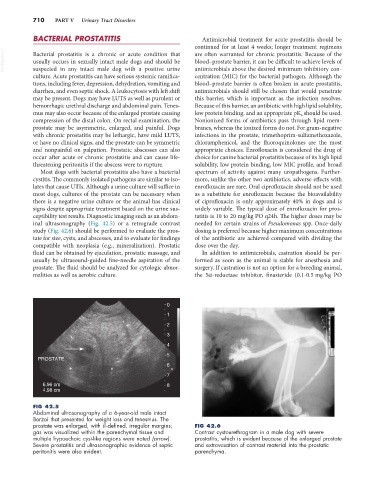Page 738 - Small Animal Internal Medicine, 6th Edition
P. 738
710 PART V Urinary Tract Disorders
BACTERIAL PROSTATITIS Antimicrobial treatment for acute prostatitis should be
continued for at least 4 weeks; longer treatment regimens
VetBooks.ir usually occurs in sexually intact male dogs and should be are often warranted for chronic prostatitis. Because of the
Bacterial prostatitis is a chronic or acute condition that
blood–prostate barrier, it can be difficult to achieve levels of
suspected in any intact male dog with a positive urine
centration (MIC) for the bacterial pathogen. Although the
culture. Acute prostatitis can have serious systemic ramifica- antimicrobials above the desired minimum inhibitory con-
tions, including fever, depression, dehydration, vomiting and blood–prostate barrier is often broken in acute prostatitis,
diarrhea, and even septic shock. A leukocytosis with left shift antimicrobials should still be chosen that would penetrate
may be present. Dogs may have LUTS as well as purulent or this barrier, which is important as the infection resolves.
hemorrhagic urethral discharge and abdominal pain. Tenes- Because of this barrier, an antibiotic with high lipid solubility,
mus may also occur because of the enlarged prostate causing low protein binding, and an appropriate pK a should be used.
compression of the distal colon. On rectal examination, the Nonionized forms of antibiotics pass through lipid mem-
prostate may be asymmetric, enlarged, and painful. Dogs branes, whereas the ionized forms do not. For gram-negative
with chronic prostatitis may be lethargic, have mild LUTS, infections in the prostate, trimethoprim-sulfamethoxazole,
or have no clinical signs, and the prostate can be symmetric chloramphenicol, and the fluoroquinolones are the most
and nonpainful on palpation. Prostatic abscesses can also appropriate choices. Enrofloxacin is considered the drug of
occur after acute or chronic prostatitis and can cause life- choice for canine bacterial prostatitis because of its high lipid
threatening peritonitis if the abscess were to rupture. solubility, low protein binding, low MIC profile, and broad
Most dogs with bacterial prostatitis also have a bacterial spectrum of activity against many uropathogens. Further-
cystitis. The commonly isolated pathogens are similar to iso- more, unlike the other two antibiotics, adverse effects with
lates that cause UTIs. Although a urine culture will suffice in enrofloxacin are rare. Oral ciprofloxacin should not be used
most dogs, cultures of the prostate can be necessary when as a substitute for enrofloxacin because the bioavailability
there is a negative urine culture or the animal has clinical of ciprofloxacin is only approximately 40% in dogs and is
signs despite appropriate treatment based on the urine sus- widely variable. The typical dose of enrofloxacin for pros-
ceptibility test results. Diagnostic imaging such as an abdom- tatitis is 10 to 20 mg/kg PO q24h. The higher doses may be
inal ultrasonography (Fig. 42.5) or a retrograde contrast needed for certain strains of Pseudomonas spp. Once-daily
study (Fig. 42.6) should be performed to evaluate the pros- dosing is preferred because higher maximum concentrations
tate for size, cysts, and abscesses, and to evaluate for findings of the antibiotic are achieved compared with dividing the
compatible with neoplasia (e.g., mineralization). Prostatic dose over the day.
fluid can be obtained by ejaculation, prostatic massage, and In addition to antimicrobials, castration should be per-
usually by ultrasound-guided fine-needle aspiration of the formed as soon as the animal is stable for anesthesia and
prostate. The fluid should be analyzed for cytologic abnor- surgery. If castration is not an option for a breeding animal,
malities as well as aerobic culture. the 5α-reductase inhibitor, finasteride (0.1-0.5 mg/kg PO
0
1
+ + 2
3
4
5
PROSTATE
6
+ +
7
6.96 cm 8
4.98 cm
FIG 42.5
Abdominal ultrasonography of a 6-year-old male intact
Borzoi that presented for weight loss and tenesmus. The
prostate was enlarged, with ill-defined, irregular margins; FIG 42.6
gas was visualized within the parenchymal tissue and Contrast cystourethrogram in a male dog with severe
multiple hypoechoic cyst-like regions were noted (arrow). prostatitis, which is evident because of the enlarged prostate
Severe prostatitis and ultrasonographic evidence of septic and extravasation of contrast material into the prostatic
peritonitis were also evident. parenchyma.

